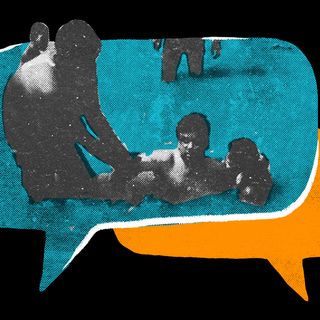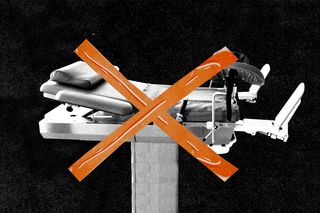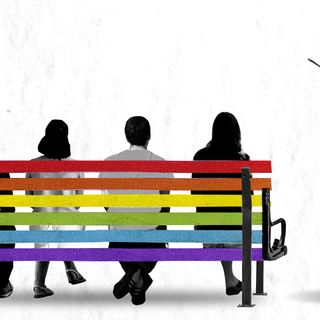
After Roe V. Wade Overturning, Indians Are Rushing to Prove Their Superiority. Here’s Why That’s Dangerous.
The social response is a textbook case of moral licensing, showing why one progressive act in the past doesn’t mean progress for everyone, everywhere.

This is a story of a reality sordid and sour, a pride jingoistic and misplaced, and the elimination of a civil right that forever changes the story of women and their bodily autonomy in another country and, arguably, the world over.
We start in India, on the fateful evening of Friday, when news broke of the U.S. Supreme Court overturning Roe v. Wade, a 50-year-old landmark judgment guaranteeing women’s reproductive right to abortion. There was a collective feeling of despair and daze: where did we — not the West, not India — but we as a global social consciousness go wrong? The fight to access reproductive justice through abortion laws was a touchstone and legacy of the women’s liberation movement in many parts of the world. The global response was not so much so a reckoning, but a despondency that was hard to shake off. It was a rude awakening from a dream of “progress.” The conversation in Indian circles, however, soon shifted to one of pride; where people regaled about “being proud to live in India” where abortion isn’t criminalized. We, at last, trumped the progressive West, it would seem. As the West took a step back, India “showed the way.” Nationalistic pride swelled people’s senses. Our anxiety over cultural dominance had met a rather opportune happenstance.
But there remains something amiss in this moment of supposed glee and chest-thumping. How “progressive” is India really when it comes to abortion? To frame it differently: how easily can people access safe and affordable abortions here, despite the technical legality of the procedure?
“I’m glad that we’re talking about abortions in India, which is normally not talked about at all,” says Dr. Esha Chainani, a Mumbai-based gynecologist “But I think people are really missing the point of how fragile this [whole conversation] is.”
The point is this: Access to abortion is a social and medical issue as much as it is a legal one. Legally, the Indian government allows for abortion under the Medical Termination of Pregnancy (Amendment) Act 2021, under very carefully specified conditions. But stigma in the Indian society, along with lack of mobility and financial agency, still restricts women’s access to abortion. India’s abortion laws are also famously criticized for not being rights-based; in other words,they don’t center on the autonomy of the individual but require a whole maze of medical bureaucracy to sanction the abortion. “India’s failure to recognize abortion as a ‘right’ could have glaring implications for the lakhs of women who face legal, physical, and social barriers affecting their access to reproductive healthcare services,” wrote legal researcher Malavika Parthasarathy.
In ignoring this key fact, people celebrating India’s supposed ideological “progressiveness” becomes a textbook case of “moral licensing.” It is a social psychological phenomenon that best explains why one good deed doesn’t lead to more good deeds, or why the trajectory of progress doesn’t always tilt upwards. Or, let’s say, why legal provisions that allow for abortion don’t necessarily translate into affordable and accessible abortion. It is akin to a “moral glitch,” as a blog noted, where morality on one account inflates our self-image and pride to such an extent that we drop our guards against other immoral behavior.
Related on The Swaddle:
Body Matters: Navigating Abortion in India
Here’s how this works. Right now, people are falsely equating the absence of an abortion ban in India with individual autonomy over bodies. People virtue signal our “open-mindedness” by appreciating India’s abortion laws, without actively acknowledging the scope of the laws, the fine print seeped within, and their very efficacy. Malcolm Gladwell explained this “psychological bargaining” in his podcast, showing how people become blind to the things they are or aren’t doing. In other words, a society can hate women but still gush over its stance on reproductive rights because it allows for people’s moral elevation.
As Gladwell noted, “it explains how when people initially behave in a moral way, they are more likely to display behaviors that are immoral, unethical, or problematic in other ways later.” For instance, people who expressed support for President Barrack Obama’s presidency were more likely to be racist or prejudiced afterward, according to a 2010 study. They had earned moral goodwill from their show of political expression. Or, people who vote for female leaders or are appreciative of women in politics are more likely to be sexist and engage in misogyny in real life. There’s no way they could be sexist if they voted for a woman, yes? Moral licensing, in other words, becomes a license to discriminate more.
This social response in India also speaks to the romantic notions of the progress we clutch onto. Social progress is bewitching because it promises wonders with an imprecise, inexplicable perfection. But one step through one door doesn’t promise a smooth passage. Instead of women and minorities having to justify why abortion access is still muddled with obstacles, the conversation of progress must demand critique and scrutiny from those who rush to declare new dawn.
***
So here’s what we should know about abortion access in India; the obstacles to abortion access and care are multifold. “A lot of people don’t know about abortion access. There are a lot of like myths about this as a lot of non–information is given out,” Dr. Chainani notes. While the amendment to India’s abortion law is a step in the right direction, it comes with certain caveats. And there is no better or more important time to understand them than now.
Medically, married women are eligible for an abortion if the contraceptive failed; single women, on the other hand, must indicate there was an element of coercion that led to the pregnancy. So while she notes the amendment to MTP Act is progressive, it’s still not the pinnacle of freedom. There is no way you can get an abortion by choice. “There are very few ways that you are eligible for an abortion,” explains Dr. Chainani. “One, is that there’s a failure of a contraception method that you’ve used. Or, if the mother is not strong enough to carry the baby physically; as in any kind of major disease, things like that. Or, there’s something wrong with a baby that you can’t carry into. These are the only ways to be eligible for an abortion. If you’ve not used any contraception, and you’ve gotten pregnant, and now you do notwant this baby out of choice, unfortunately, Indian law doesn’t let you do it.”
“You’re still limiting choice, right? You’re still saying that here are five ways that you can get an abortion, but not every way you can get an abortion.”
Two things strike out here: that the individual must bear the responsibility of proving how the pregnancy will harm them physically or emotionally. And this makes the medical practitioner’s opinion the deciding factor. For instance, people can get an abortion up to 24 weeks of pregnancy now, as opposed to 21 weeks as per the earlier law, but that still has to be decided by a medical body. Yet, this medical body is not set up in every district or city, Dr. Chainani notes, which further risks sidelining people from rural areas or peri-urban areas.
There is a worrying library of people documenting the prejudice and ideological abuse they face at gynecologists’ clinics and local government hospitals; the judgment of aborting a child, or having pre-marital sex, is humiliating and pervasive. Abortion laws are also very gendered. “Earlier, the laws mentioned access to ‘married women’ only, which was ridiculous,” Dr. Chainani notes. “They have dropped it now which is great. But it still says women, so for the trans community and nonbinary community, the laws are still very regressive.” This is a moment to think about how we can be inclusive with regard to abortion access, instead of being content with the fact that abortion is not criminalized.
Celebrating the legal access to abortion also overlooks the systemic barriers and infrastructural inadequacies that capture the true realities of reproductive care. Abortion access is threatened by a deluge of logistical issues: travel restrictions, non-availability of childcare and contraception, and financial agency to take decisions. There remains a dearth of gynecologists in villages along with limited awareness around contraceptive usage. In rural areas, in particular, travel distance and monetary limitations restrict people’s access to clinics. This is in addition to the myths and stigma that make abortions an unspeakable taboo.
Related on The Swaddle:
The Most Traumatic Thing About Abortions Is the Judgment
In urban areas, misinformation prevails around requiring consent too. “You don’t need anyone else’s consent to have an abortion if you are 18 or above. For a medical abortion, you can come to a gynecologist, and all the papers need is your signature, explains Dr. Chainani.
Interestingly, a sessions court in Punjab in 2007 observedthat a woman’s decision to undergo an abortion without her husband’s consent amounted to cruelty. But legally, as we know, “it’s only you and only your consent; you do not even need your partner’s consent.”
But this, too, can be conditional. For pregnancies over the six to seven-week mark, abortions are administered surgically — which involves relatives for purposes of consent while a person is under anesthesia. “Moreover, if someone is less than the age of 18, then they need the parent or guardian to come and sign with you,” Dr. Chainani adds.
Anecdotally, however, people have been asked to show a parent’s or partner’s consent when accessing abortion services even when not legally required to. “I’ve had two procedures. One was a D&C when I was 18. I didn’t tell my mom because legally I think once you are 18 you are allowed to do it on your own — you don’t need a guardian. The gynac… said that she’ll only treat me if my mom comes because she said I was too young,” S.G. told The Swaddle earlier this year.
Since consent is ingrained in the process, the systemic must work to move towards the people, not isolate them further. “The law says that if you’re not going to do it for moral, spiritual, ethical reasons, it is your duty to refer them to a doctor who will actually do it; not simply wash your hands off the patient who are then left wondering where to go or whom to approach,” Dr. Sujatha Rajnikanth, a gynecologist, told The Swaddle.
Women’s health is already sidelined in the biomedical framework of medicine. The “pain” after abortion procedures is, then, often not spoken about or easily dismissed. In many cases, people in India report not being warned about the pain or finding easily available recourse options. The restricted care presents obstacles more pointedly for single women and those without family ecosystems.
Further, there is alsoa tendency to muddle up reproductive freedom with sex-selection abortions (according to a study, an estimated 6.8 million fewer female births will be recorded across India by 2030 due to sex-selective abortions). “There is a lot of confusion between abortion and sex-selective abortions. Terms like ‘female foeticide’ attributing personhood to fetus instead of ‘sex-selective abortions’ are used interchangeably and create confusion,” noted journalist Neha Dixit. Sex-selective abortions by no means are a symbol of bodily empowerment. Sex-selective abortions continue to be rampant, but at the same time, people are ostracized and face tangible obstacles to exercising their choice. That both these facts co-exist speaks to the complexity of abortion as a reproductive right in India, and why it carries cultural baggage that we’re not equipped to understand by viewing the issue from a Roe v. Wade point of view alone.
***
“I think it’s a little scary because when you see a developed economy making regressive steps like this, it does scare you,” admits Dr. Chainani. “If it can happen in what we thought was a very progressive country, then it can happen anywhere.”
When India overturned its abortion ban, the court quoted Roe v. Wade. [The Medical Termination of Pregnancy Act, was passed by Parliament in 1971 and came into effect in 1972. Before that, abortion was a criminal offense under the Indian Penal Code].
This is a time for taking stock. The conversation about abortion access must also include raising awareness about contraceptive use. And equally important is the need to realize the tectonic cultural shifts. Now comes a more uncomfortable question: Do India and its policy on abortion grant that freedom to people in India?
It is hard to shake the feeling of despair and cataclysm. Once we overcome this daze and look beyond the myopic pride, the gaze must dart towards shades of gray that threaten abortion access from a class, caste, gender, and institutional lens. Just because India is standing still with regards to abortion doesn’t mean it’s necessarily heading in a “progressive” direction. The true, inclusive idea of progress must be constant and consistent. More importantly, it has to be about the people, about the individual claim to autonomy, than the “function” they represent. “Losing ground on the issue of legal, safe, inexpensive abortion means that women lose ground on all reproductive issues,” as bell hooks wrote.
Dr. Chainani says that with the end of Roe v. Wade as we know it, “I think now you can’t take anything for granted.”
Saumya Kalia is an Associate Editor at The Swaddle. Her journalism and writing explore issues of social justice, digital sub-cultures, media ecosystem, literature, and memory as they cut across socio-cultural periods. You can reach her at @Saumya_Kalia.
Related


Nothing Wrong With Wandering Around Streets Late at Night in a City Like Mumbai, Court Rules
